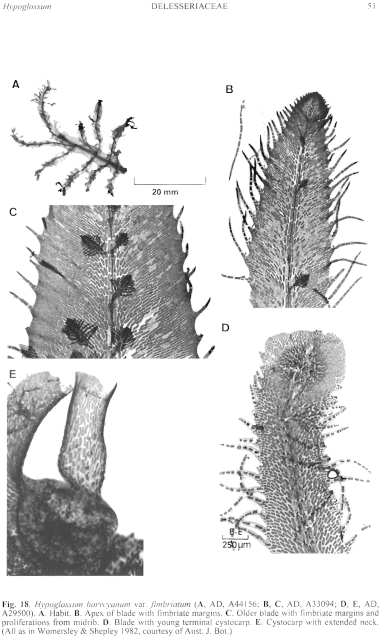|
|
|
|
|
|||||||||||
|
Electronic Flora of South Australia Species Fact Sheet
Phylum Rhodophyta – Family Delesseriaceae
Type: from Saunders Beach, Kangaroo I., S. Aust., drift (Shepley, 25.viii.1963; holotype in AD, A29500).
Selected specimens: Point Turton, S. Aust., 3–5 m deep on rock and jetty piles (Kraft, 17.ix.1973; AD, A44156) and 8–9 m deep (Kald, 8.vi.1968; AD, A33094).
Distribution: Known from Point Turton and Saunders Beach, Kangaroo I., S. Australia.
Taxonomic notes: Morphology and cell lineages as in the species, but with second-order rows extended into uniseriate projections 5–20 cells long, and cystocarps surmounted by long and broad necks, 500–1500 µm long and 200–400 µm in diameter, often flared at their tips.
This variety (Fig. 18A) is of distinctive morphology with the second-order cell rows in the smaller blades extended into uniseriate projections 5–20 cells long, which give these blades a fimbriate appearance (Fig. 18B–D). However, in the development of the blades, the further development of the second-order rows, and cortication of older blades, they show the essential features of H. harveyanum, though often the blades remain somewhat narrower. Older blades are typically those of H. harveyanum.
The tetrasporangial sori (Point Turton plants only) appear essentially similar to those of New South Wales plants, though the first corticating cells are cut off distinctly before the tetrasporangium, but the cystocarps of the single Saunders Beach fimbriate plant are remarkable. The cystocarp size is rather greater (1000–1500 µm in diameter), but it is surmounted by a very long and broad neck 500–1500 µm long and 200–400 µm in diameter that is slightly narrowed near its base and expanded above, often flared outwards at its tip (Fig. 18E). The carposporangia of this plant are also somewhat larger than in New South Wales plants.
These South Australian records are well outside the geographical range of typical H. harveyanum, which is otherwise confined to the central New South Wales and southern Queensland coasts. It is noteworthy, however, that the Queensland collections show longer `spines' to the second-order rows than the New South Wales plants, but usually not as extensively developed as in the South Australian plants. However, AD, A50523 from Gladstone, Qld (Moverley, 25.viii.1977), has marginal spines up to 25 cells long.
This variety was previously regarded (Womersley & Shepley 1982, p. 334, fig. 6); as a fimbriate form, but it now appears best, with the limited collections available, to regard the South Australian plants as a variety of the N.S.W. species. Study of further collections is necessary, especially of the thallus development and cystocarps and their variation, to assess the status of these plants. The Queensland plants also warrant further study on their variation.
References:
WOMERSLEY, H.B.S. & SHEPLEY, E.A. (1982). Southern Australian species of Hypoglossum (Delesseriaceae, Rhodophyta). Aust. J. Bot. 30, 321–346.
The Marine Benthic Flora of Southern Australia Part IIID complete list of references.
Publication:
Womersley, H.B.S. (24 February, 2003)
The Marine Benthic Flora of Southern Australia
Rhodophyta. Part IIID. Ceramiales – Delesseriaceae, Sarcomeniaceae, Rhodomelaceae
Reproduced with permission from The Marine Benthic Flora of Southern Australia Part IIID 2003, by H.B.S. Womersley. Australian Biological Resources Study, Canberra. Copyright Commonwealth of Australia.
Illustration in Womersley Part IIIA, 2003: FIG. 18.

Figure 18 enlarge
Fig. 18. Hypoglossum harveyanum var. fimbriatum (A, AD, A44156; B, C, AD, A33094; D, E, AD, A29500). A. Habit. B. Apex of blade with fimbriate margins. C. Older blade with fimbriate margins and proliferations from midrib. D. Blade with young terminal cystocarp. E. Cystocarp with extended neck. (All as in Womersley & Shepley 1982, courtesy of Aust. J. Bot.)

|
Email Contact: State Herbarium of South Australia |

|